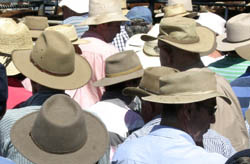
Rural and agricultural populations across the globe have higher skin cancer risks due to the nature of their work.
Australia has the highest rate of skin cancer in the world. Farmers have a 60% higher death rate from melanoma compared to the general population and skin cancer deaths in farmers over 65 are double compared to other Australians.
Hazards and risks
Farmers spend significant time working outdoors during peak ultraviolet (UV) times. Sun protective behaviours are vital to prevent skin cancer, however skin protection behaviours in farm men and women are often low. (Smit-Kroner & Brumby, 2015)
UV index measures UV levels on a scale from 0 (low) to 11+ (extreme). Sun protection is recommended when UV levels are 3 (moderate) or higher. Factors including the time of day, time of year, cloud cover, altitude, and reflection will affect UV levels.
Skin cancer is preventable. The majority of skin cancers can be successfully treated, if found early. Be familiar with your skin and look for any changes, suspicious lumps or spots and act on any changes as soon as they develop. Don’t just rely on an annual skin check to detect any suspicious spots as skin spots can change between reviews.
Skin protective practice in farmers and agricultural workers includes wearing protective clothing such as long sleeved shirts and trousers, a broad brim hat and sunglasses.)
Recommendations to reduce skin cancer with other sun protection strategies for farmers and agricultural workers to prevent skin cancer include:
- Become familiar with the UV index predicted for the day. Download an UV app onto your mobile device
- Seek shade and avoid working outdoors in the middle of the day if possible.
- Slide on sunglasses, ensuring they are AS/NZS compliant and fitted with side arm, as melanoma can also develop in eyes.
- Slop on SPF 50+ sunscreen and remember to reapply during the day. Putting sunscreen on the skin before heading out in to the sun will allow it to dry effectively and reduce dust sticking to the skin.
- Slap on a broad-brimmed hat as it provides more protection than a peak cap
- Seek regular skin checks with your GP or skin specialist.
- Ensure you apply a duty of care to farm workers by providing sun protection.
For more information on protecting outdoor workers visit Better Health Channel
Find out more information about skin cancer prevention visit Cancer Council Australia.
Fast Facts
- Farmers and agricultural workers have an increased risk of developing skin cancer.
- UV levels are highest during the middle of the day
- Sun protection is required when the UV index is predicted to be 3 or above.
- Use the five sun protection combinations of: Slip on a long sleeve shirt and/or trousers, Slop on SPF 50+ sunscreen, Slap on a broad-brim hat, Slide on sunglasses and Seek shade.
- Download the free SunSmart App on your mobile to access the UV index throughout the day.
- If possible leave an outdoor task to later in the day or another day when the UV index is not as high.
- Monitor changes in your skin and have regular skin checks to assist with early detection of skin cancers.
References used for this topic
More information:
SafeWork Australia
Protection of workers from the ultraviolet radiation in sunlight [PDF]
Better Health Victoria
Skin cancer – risk factors
Cancer Council
UV radiation at work
Clinical care:
Royal Australian College of General Practitioners (RACGP)
Early detection of cancers – skin cancer
Research & reviews:
Cancer Council Victoria
Farmers’ and outdoor workers’ beliefs about skin cancer and protection [PDF 257kb]
Preventive Medicine Reports
Farmers sun exposure, skin protection and public health campaigns: An Australian perspective
|
|